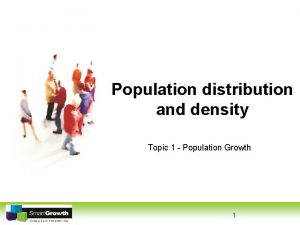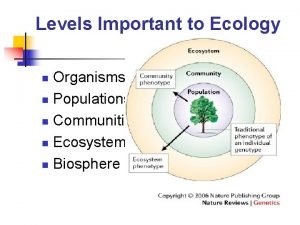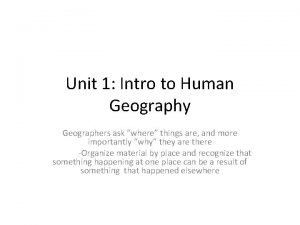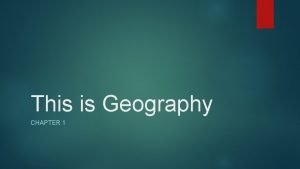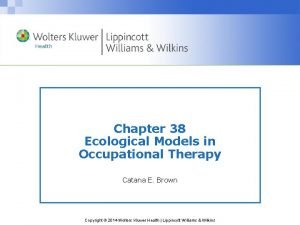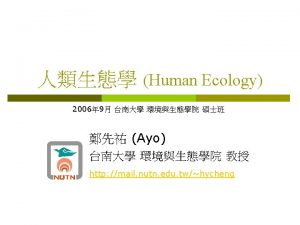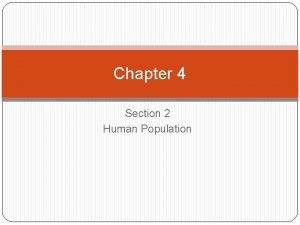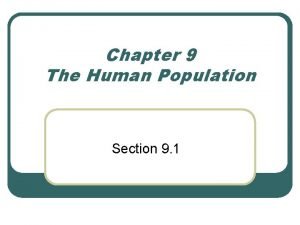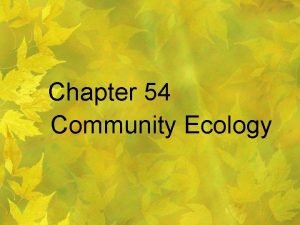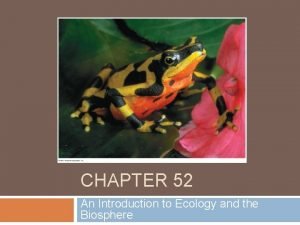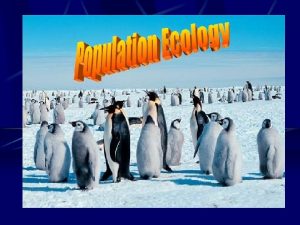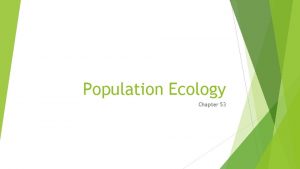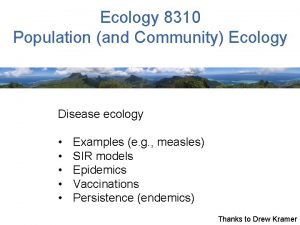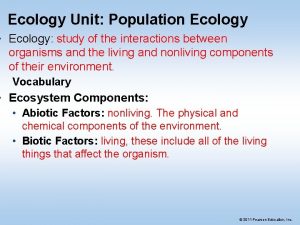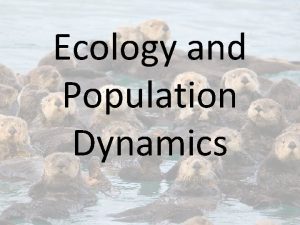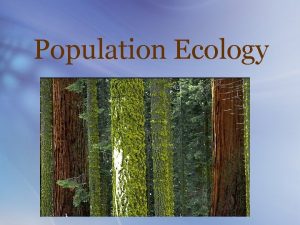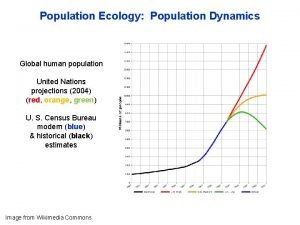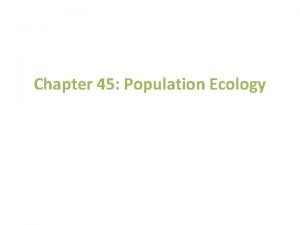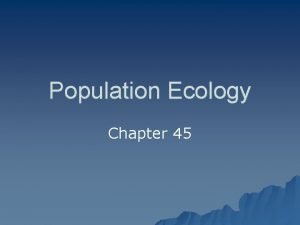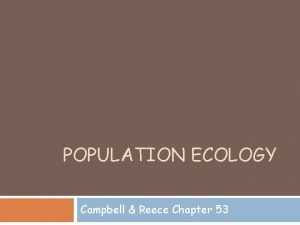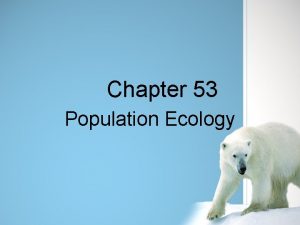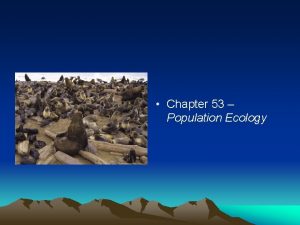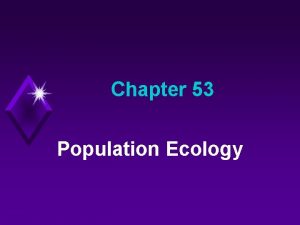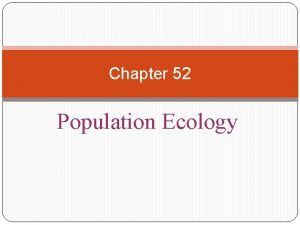Chapter 13 Population Ecology Is the Human Population




































- Slides: 36

Chapter 13 Population Ecology Is the Human Population Too Large? Copyright © 2010 Pearson Education, Inc.

Chapter 13 Section 1 A Growing Human Population Copyright © 2010 Pearson Education, Inc.

13. 1 A Growing Human Population § Earth’s human population is 6. 6 billion § UN estimates that population will grow to 10. 3 billion by 2050 § 854 million people already do not get enough to eat § 55% of childhood mortality is due to poor nutrition Copyright © 2010 Pearson Education, Inc.

13. 1 A Growing Human Population Definitions § Ecology = study of the interaction among organisms and between organisms and their environment § Population = all the individuals of a species in a given area Copyright © 2010 Pearson Education, Inc.

13. 1 A Growing Human Population Structure § Estimating size of population is the most basic task. Populations can be measured in a variety of ways § Basic census – all individuals counted (humans, trees, etc. ) § Mark-recapture – estimate of population size § some individuals trapped, marked, and released § In later trapping, ratio of marked to unmarked individuals used to estimate population size Copyright © 2010 Pearson Education, Inc.

13. 1 A Growing Human Population Structure Example of Mark-Recapture 1 Researcher captures 100 beetles in a trap, marks each with a dab of paint. Copyright © 2010 Pearson Education, Inc. 2 After one week, a trap is set again, resulting in a captured group of marked and unmarked individuals. 3 Total population is estimated as equivalent to the percentage of marked individuals in the second trap. Figure 13. 1

13. 1 A Growing Human Population Structure Population dispersion – how a population is distributed in space. § Clumped – high densities in resource-rich areas, low densities elsewhere § Uniform – spacing between individuals tends to be equal § Random – no compelling feature pushing individuals together or apart Copyright © 2010 Pearson Education, Inc. Figure 13. 2

13. 1 A Growing Human Population – Human Population Growth: An Overview § Archaeologists have been able to estimate the size of human population to about 10, 000 years ago § Human population is an example of exponential growth § Exponential growth is in proportion to population size § As population grows, growth also increases Copyright © 2010 Pearson Education, Inc. Figure 13. 3

13. 1 A Growing Human Population Growth § § Growth rate was ~0. 1% per year 2000 years ago By 1750 growth rate was ~2% per year Currently growth rate is ~1. 2% per year Current population of earth 6. 6 billion, at 1. 2% growth rate this means population increases by 77 million people/year Copyright © 2010 Pearson Education, Inc.

13. 1 A Growing Human Population Growth Rate Explained § Growth rate is represented by “r” § r = (birth rate – death rate) § Example § If birth rate = 20 births / 1000 = 2. 0% § And death rate = 8 deaths / 1000 = 0. 8% § Then r = 2. 0 – 0. 8 = 1. 2% Copyright © 2010 Pearson Education, Inc.

13. 1 A Growing Human Population Consider growth rate as time it takes a population to double Copyright © 2010 Pearson Education, Inc. Figure 13. 4 b

13. 1 A Growing Human Population The Demographic Transition § Generally in human populations, a decrease in death rate is followed by a decrease in birth rate = demographic transition § Before industrial revolution, both birth and death rates were high § With industrialization death rates decreased Copyright © 2010 Pearson Education, Inc. Figure 13. 5

13. 1 A Growing Human Population The Demographic Transition § Lag time between decrease in death rate and birth rate has major impact on population size § Many developing countries still in demographic transition § These developing countries are where majority of famines already occur § Is the human population already to large? Copyright © 2010 Pearson Education, Inc. Figure 13. 5

13. 1 A Growing Human Population PLAY Animation—Population Growth Copyright © 2010 Pearson Education, Inc.

END Chapter 13 Section 1 A Growing Human Population Copyright © 2010 Pearson Education, Inc.

END Chapter 13 Section 2 Limits to Population Growth Copyright © 2010 Pearson Education, Inc.

13. 2 Limits to Population Growth Studies of non-humans species show that no population can grow to unlimited numbers § Elk in Yellowstone Park in 1970 s had high mortality after large population degraded environment § Norway lemmings population grows so large that resources become scarce and population undertakes mass migration Copyright © 2010 Pearson Education, Inc.

13. 2 Limits to Population Growth Carrying Capacity and Logistic Growth § Populations have the potential to grow exponentially § Carrying capacity = the maximum number of individuals that can be supported indefinitely in a given environment No Growth Population size § but they are limited by environmental resources – food, water, shelter, and space. Carrying capacity Time Copyright © 2010 Pearson Education, Inc. Figure 13. 6

13. 2 Limits to Population Growth - Carrying Capacity and Logistic Growth Limits on population growth: § Density-dependent factors – factors that increase with population size § Limited food supply, increased risk of disease, increase in waste levels § Can cause decrease in birth rates, increase in death rates, or both § Density-independent factors – not influenced by population numbers § Droughts, temperature extremes, natural disasters Copyright © 2010 Pearson Education, Inc.

13. 2 Limits to Population Growth - Carrying Capacity and Logistic Growth Limits on population growth: Fruit Flies § When grown in the laboratory, as the population grows: § Food becomes limited § Waste accumulates § Leads to increased mortality Copyright © 2010 Pearson Education, Inc.

13. 2 Limits to Population Growth - Carrying Capacity and Logistic Growth Limits on population growth: Water Fleas § When grown in an aquarium, as the population grows: § Food becomes limited § Females do not have enough energy for egg production § Leads to decreased birth rate Copyright © 2010 Pearson Education, Inc.

13. 2 Limits to Population Growth - Carrying Capacity and Logistic Growth Limits on population growth: White-tailed Deer § When natural habitat becomes crowded: § Food becomes limited § Females do not have enough energy to carry pregnancy to term § Leads to decreased birth rate Copyright © 2010 Pearson Education, Inc.

13. 2 Limits to Population Growth There is uncertainty about future human population growth rates § Human population growth rates at highest in 1960 s, ~2. 1% § Growth rates now about 1. 2% § Unclear what future trends are, UN has released 3 projections Copyright © 2010 Pearson Education, Inc. High growth rate Medium growth rate Low growth rate Human population (billions) Earth’s Carrying Capacity for Humans Year Figure 13. 8

13. 2 Limits to Population Growth - Earth’s Carrying Capacity for Humans Signs that Earth is Not Near Carrying Capacity § One reason for declining growth rates is choice § Earth’s resources can be measured by net primary productivity – the total amount of plant growth § Estimates of net primary productivity indicate that a human population of 20 billion could be supported § But this assumes that all plant growth fed humans and nothing else Copyright © 2010 Pearson Education, Inc.

13. 2 Limits to Population Growth - Earth’s Carrying Capacity for Humans Signs that Population is Nearing Carrying Capacity § Populations require more than simply food, thus net primary productivity estimates might be too high. § Humans need clean water, but also produce waste. § Many essential supplies are non-renewable resources. § Material consumption is affected by lifestyle and affluence. § USA accounts for ~5% of world’s population but consumes 24% of global energy resources. Copyright © 2010 Pearson Education, Inc.

END Chapter 13 Section 2 Limits to Population Growth Copyright © 2010 Pearson Education, Inc.

Chapter 13 Section 3 The Future of the Human Population Copyright © 2010 Pearson Education, Inc.

13. 3 The Future of the Human Population A Possible Population Crash? § The cycle of growth beyond carrying capacity leads to population crashes and, sometimes, rebounds. Boom-and-bust cycle may persist… …or population may stabilize at carrying capacity. Population size Boom Carrying capacity Crash Time Copyright © 2010 Pearson Education, Inc. Time Figure 13. 11

13. 3 The Future of the Human Population Example: Easter Island (Rapa Nui) § The island is very isolated in the Pacific § Could only use resouces on island § Island was once a tropical forest and supported 7000 people § They destroyed the forest and population crashed by 1775 to 700 Copyright © 2010 Pearson Education, Inc. Figure 13. 11

13. 3 The Future of the Human Population - A Possible Population Crash? § Demographic momentum = time lag between when humans reduce birth rates and when population growth begins to slow § Even while parents are reducing family size, their children grow and have children. § Even when parents have two children (replacement), population will continue to grow for 60 or 70 years until stable. Copyright © 2010 Pearson Education, Inc.

13. 3 The Future of the Human Population - A Possible Population Crash? § A population pyramid with a large base indicates that the majority of the population is young and that the population is still growing Age (b) United States in 2000 Age (a) South Africa in 2000 Reproductive years Males Females (population in millions) Copyright © 2010 Pearson Education, Inc. Females Males (population in millions) Figure 13. 13

13. 3 The Future of the Human Population Avoiding Disaster § For humans, other factors also affect population growth rate, including: § income and women’s literacy. Copyright © 2010 Pearson Education, Inc.

13. 3 The Future of the Human Population - A Possible Population Crash? Avoiding Disaster § Thus, social policies can have large impacts on human population growth. § The question of how many people the earth can support is not just one of science, but of values and ethics. Copyright © 2010 Pearson Education, Inc.

13. 3 The Future of the Human Population - A Possible Population Crash? Quality of Life? § The “American Lifestyle” is only supported by using resources from other countries § But global carrying capacity only provides enough food and water § But who wants such a world? § To have a rich, rewarding life, we must be well below the carrying capacity, ensuring a bountiful nature and diversity of other species Copyright © 2010 Pearson Education, Inc. Figure 13. 14

End Chapter 13 Section 3 The Future of the Human Population Copyright © 2010 Pearson Education, Inc.

End Chapter 13 Copyright © 2010 Pearson Education, Inc.
 Chapter 4 population ecology section 1 population dynamics
Chapter 4 population ecology section 1 population dynamics Population ecology chapter 4 answers
Population ecology chapter 4 answers Population ecology section 1 population dynamics answer key
Population ecology section 1 population dynamics answer key Population ecology section 1 population dynamics
Population ecology section 1 population dynamics Chapter 53 population ecology
Chapter 53 population ecology Equilibrial life history
Equilibrial life history Chapter 4 population ecology answer key
Chapter 4 population ecology answer key Chapter 53 population ecology
Chapter 53 population ecology Chapter 4 section 1 population dynamics
Chapter 4 section 1 population dynamics Chapter 53 population ecology
Chapter 53 population ecology Clumped dispersion
Clumped dispersion Exponential growth formula ecology
Exponential growth formula ecology 52
52 Population vs community ecology
Population vs community ecology Concept 3 population ecology
Concept 3 population ecology Population def ecology
Population def ecology Characteristics of population ecology
Characteristics of population ecology Population characteristics
Population characteristics Ideal population growth curve
Ideal population growth curve Population definition ecology
Population definition ecology Population ecology
Population ecology Parasitism
Parasitism Perceptual region definition
Perceptual region definition 3 pillars of sustainability ap human geography
3 pillars of sustainability ap human geography Ecology of human performance model
Ecology of human performance model Human ecology
Human ecology P what
P what Chapter 4 section 2 human population
Chapter 4 section 2 human population Chapter 9 the human population section 1
Chapter 9 the human population section 1 8.3 human needs
8.3 human needs Chapter 8 human needs and human development
Chapter 8 human needs and human development Chapter 52: an introduction to ecology and the biosphere
Chapter 52: an introduction to ecology and the biosphere Section 1 community ecology
Section 1 community ecology Chapter 56 conservation biology and restoration ecology
Chapter 56 conservation biology and restoration ecology Phosphorus cycle pearson education
Phosphorus cycle pearson education Chapter 54: community ecology answer key
Chapter 54: community ecology answer key Chaparral climograph
Chaparral climograph




















